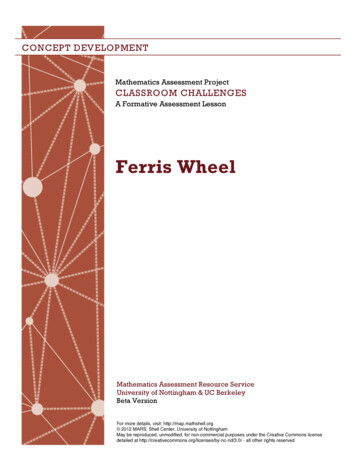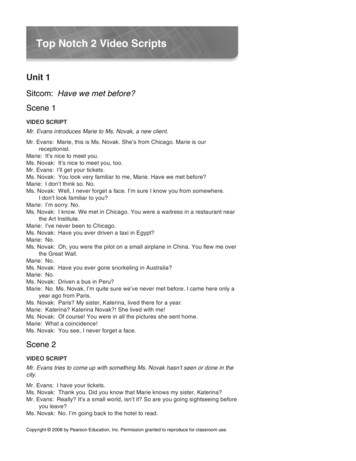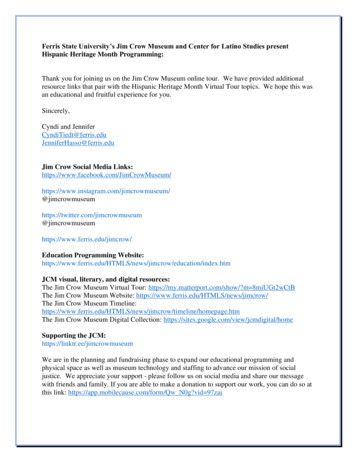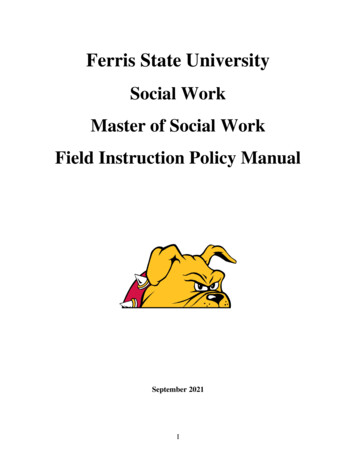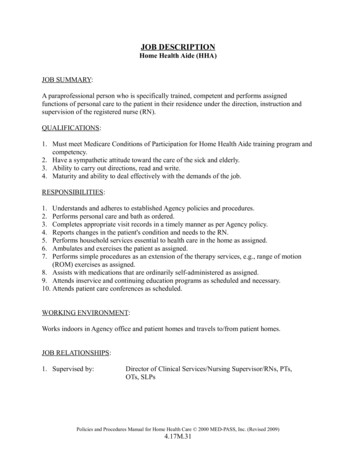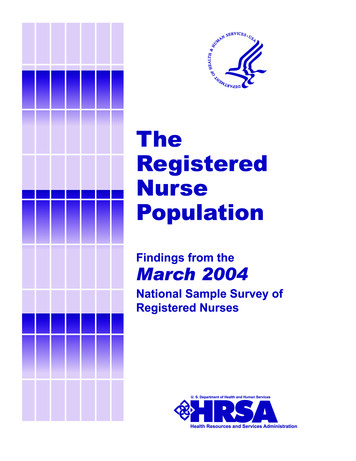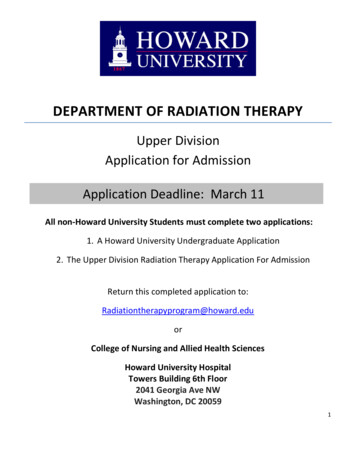
Transcription
Running head: NURSE RETENTION1Nurse RetentionCheryl HowardFerris State University
NURSE RETENTION2AbstractNursing shortage and turnover affects the quality and safety of patient care, nurse workenvironments and the operations of health care organizations. This paper outlines researchcollected about nursing shortage, nurse turnover and nurse retention in order to explore the topicand provide evidence based recommendations for nursing retention. Topics at hand are defined.Interdisciplinary theories relating to nurse retention are explained including the Nueman SystemsModel in nursing and Kanter’s Empowerment Theory in management. An assessment of thehealth care environment is fully explored including statistics, systems framework, policies,assumptions and quality and safety issues. A brief synopsis of the past, present and future of thenursing shortage is included as part of the health care environment assessment. A root causeanalysis is outlined including the problem, causes and recommendations. Inferences,implications and consequences are related to standards and competencies from the ANA andQSEN. Opposing viewpoints are also offered. The conclusion of this paper is that health careorganizations should focus on nurse retention strategies by improving nurse job satisfaction andaddressing the nursing shortage in order to focus on the ultimate goal of patient quality andsafety.Keywords: nurse turnover, retention, shortage, quality, safety
NURSE RETENTION3Nurse RetentionThe issue of nurse retention and turnover affects both nurses and patients alike. As awhole, high nurse turnover and vacancy rates negatively affect health care access, patient carequality and nurse job satisfaction. The nursing shortage directly impacts nurse staffing levels,retention and turnover (Rosseter, 2012). Discussion about the costs and benefits of nursingretention applies to most all nursing fields and position types (Jones & Gates, 2007).Financial effects of nurse turnover are also significant. The direct and indirect cost ofreplacing a registered nurse (RN) can range from 10,000 to 60,000 (Rondeau, Williams &Wagar, 2009). It is important for health care organizations to focus on nurse retention so that thenursing shortage does not negatively affect the health of their patients, the health of theirworkforce and ultimately the financial solvency of the organization.Important TermsNursing shortage, turnover and retention are interrelated concepts. Defining theseconcepts is important in order to expand upon these subjects as a whole. Nursing shortage canbe described as lack of sufficient skilled nursing staff as well as lack of sufficiently educatedstaff that are able to care for patients (Morgan & Lynn, 2009). Turnover rate denotes anorganization’s ability to prevent existing employees from voluntarily leaving (Hayes et al.,2011). Nurse retention signifies the prevention of nurse turnover and keeping nurses employedwithin the organization (Jones & Gates, 2007).Theory BaseThe application of theories can assist with a deeper understanding by applying aconceptual perspective to the issue of nurse retention and turnover. The Neuman systems modeland Kanter’s empowerment theory are two theoretical perspectives that can help to further
NURSE RETENTION4consider the issues at hand. Principles of Kanter’s empowerment theory in the field ofmanagement can be applied to the Neuman systems model in the field of nursing in order toprovide a comprehensive, interdisciplinary approach where the whole person is honored andempowered in order to reduce stressors and retain nursing staff.Neuman Systems ModelThe Neuman systems model is a nursing theory developed by nurse and theorist BettyNeuman beginning in the 70’s and 80’s that focuses on a person as a whole and their reaction tostressors. The model’s four paradigms are person, environment, health and nursing (NursingTheories, 2012). These paradigms involve a complex interplay of variables to determinesurvival factors for stability. Neuman emphasizes prevention of primary stress response andadjustment to stress by way of secondary and tertiary prevention (Gunusen, Ustun & Gigliotti,2009).Neuman proposes that a “flexible line of defense” is mounted against stressors. Whenstressors are ongoing, such as in a nurse’s workplace, a person’s “lines of resistance” is activatedwhich attempts to prevent damage to the “central core”. This is a sort of coping mechanismwhich, if not effective, can cause signs of burnout such as physical fatigue and emotionalexhaustion. The consequences of burnout are job change, absenteeism, substance use anddepersonalization (Gunusen, Ustun & Gigliotti, 2009). The Neuman systems model illustrateshow nurse turnover can be the result of nurse reacting to work stress and damaging the “centralcore”. Changing jobs is a type of tertiary prevention which helps the person to cope.Kanter’s Empowerment TheoryRosabeth Moss Kanter is a management guru who has developed several managementtheories including the structural empowerment theory. This theory states that management’s role
NURSE RETENTION5is to provide staff with tools that will empower them in the workplace. Empowerment theoryproposes there are two types of organizational structures: power and opportunity. Employeeswith high levels of power are included in lines of information, support, resources andopportunities to learn and grow (Laschinger et al., 2010). Employees who have high levels ofopportunity in their jobs tend to be more proactive problem solvers and accept change. Whenstaff have opportunity and power, they are motivated, feel more in control, have increased wellbeing and have greater job satisfaction (Laschinger et al., 2010). These empoweringcharacteristics in the workplace will potentially promote job satisfaction, create greaterproductivity, and most importantly promote retention of valuable employees.Health Care Environment AssessmentNursing retention is a complex issue which is a sum of many parts. Policies, assumptionsand quality and safety issues must be taken into account. According to research, nurse turnoverrates in hospitals range between 1% and 20% with the average at 14% (NSI Nursing Solutions,2012). Nursing turnover in nursing home settings increases significantly, averaging 34%(Heineman, 2010). In light of these turnover statistics, it is important to note that less than halfof organizations have a formal retention strategy (NSI Nursing Solutions, 2012). The shortageof qualified nurses is related to increased turnover rates among nurses (Hunt, 2009).According to one study, 37% of newly licensed RN’s report they are ready to change jobsafter working just one year (Brewer et al., 2011). Pinchera (2012) states that, "The attrition rate[for newly licensed nurses] may be as high as 60% in their initial employment.” When newlylicensed nurses begin working they report negative emotions such as fear and feelingoverwhelmed and powerless. Inexperience, tenuous working relationships and a strong desire
NURSE RETENTION6for support that is sometimes is not available are potential reasons why new nurses do not remainwith their first employer (Pinchera, 2012).Systems FrameworkGovernment policies. Policies geared toward recruitment, retention and strengtheningnursing schools are strategies to address the nursing supply. Federal policy efforts towardstrengthening the nursing workforce focus on recruitment and retention. These policies includethe Nurse Reinvestment Act of 2002 and the Recovery and Reinvestment Act of 2009 (KaiserFoundation, 2012). The recent passing of the Affordable Care Act also has components gearedtoward improvement of the health workforce (Kaiser Foundation, 2012). The United States (US)Department of Health Resources and Services Administration has developed the NurseEducation, Practice, Quality and Retention (NEPQR) program which provides grants toaccredited schools of nursing and health care facilities in order to enhance nursing education,improve patient care quality and increase nurse retention (HRSA, 2012).Health care organization policies. National nurse leaders recommend that employersand policymakers should implement strategies to retain nurses. These strategies includesupporting retraining and skill development, discouraging policies that promote early retirementand strengthening health promotion and prevention of disability in the nursing workforce (Jeter,2008). The American Nurses Association (2012) states that recruitment and retention of RNsare, “major challenges in today’s nursing shortage environment.”Assumptions. It is possible that many assume that nurse retention is not a seriousconcern today because the nursing shortage appears to have resolved due to the recession andincreased number of nursing school graduates. There also may be a popular assumption that
NURSE RETENTION7nurse retention is not a problem in fields outside of the nursing home setting. In order to addressthis assumption, the nursing shortage’s past, present and future should be explored.Nurse shortage and recession. Nursing shortages throughout the last century have beencyclical, waxing and waning throughout the decades. However beginning in the late 1990’s, theUS experienced an acute nursing shortage. Strategies such as salary increases, sign on bonusesand an influx of foreign born nurses helped to remedy the shortage however staffing sufficientnumbers of nurses continued to be a serious problem (Buerhaus, Auerbach & Staiger, 2009).Beginning in 2001 and intensifying in the beginning of 2007, the US experienced aneconomic recession which caused RN employment to rise. The nursing shortage was abated tosome degree. Due to recession related concerns, RNs delayed plans for retirement. Also RNswhose spouses’ jobs were affected by the recession chose to return to work or change from parttime to full time status. RN employment surged and the shortage gap closed significantly as aresult of the recession and its related effects (Staiger, Auerbach & Buerhaus, 2012). The recenteconomic recession has created a "bubble" which is expected to "evaporate as the economyimproves and shortages will reemerge" (Staiger, Auerbach, & Buerhaus 2012, p. 1465).New graduates and newly licensed nurses seem to be bearing the brunt of this recessionrelated nurse shortage recovery. According to surveys conducted in 2009 and 2010, entry levelRN positions have declined (Mancino, 2011). This occurrence is not surprising given the factthat the recession has affected RN labor supply and demand. One expected effect of theincreased RN employment rate is the difficulty of new nurses in finding jobs. This effect ispredictable and the effect should be temporary (Buerhaus, Auerbach & Staiger, 2009).Projected nursing shortage. Although the recession in the US has been a short reprievefor the nursing shortage recently, the shortage still remains a serious concern in the health care
NURSE RETENTION8field. Baby boomers are aging and turning 65 at the rate of 10,000 people per day (Daley, 2012).There is an increased demand for nurses to care for this population. At the same time, the nurseworkforce is aging. Buffington et al. (2012) explain, “In the next decade, 40% of the RNworkforce will be older than 50 years or older, with many expected to retire.”Stress and burnout can cause nurses to leave the profession. High stress workenvironment also makes nursing less attractive to potential students (Morgan & Lynn, 2009).Nursing school enrollment is not sufficient to meet the demand and there is a lack of sufficientnursing faculty. Health care reform policies are also expected to increase demand for nurses. Asdemand outweighs supply, there is an increased nursing shortage projected over the next 20years (Rosseter, 2012). By the year 2020, nursing demand is expected to exceed supply by 30%in the US (Rondeau, Williams & Wagar, 2009). The nursing shortage is a real issue in theworkforce today.Quality and safety issues. RN shortage and turnover is a major concern because of theeffects on patient care, workloads and recruiting. “Concerns about RN turnover becomeheightened during times of nurse shortages” (Jones & Gates, 2007, para. 1). Nurse turnover andnursing shortage causes insufficient staffing. Insufficient staffing has effects on both patientsand nurses. For patients, insufficient staffing is related to more medical errors, higher nurse-topatient ratios, less time spent with patients, higher rates of infection and increased patientmortality. For nurses, insufficient staffing is associated with increased nurse workload, nurseburnout, low job satisfaction and higher rates of work stress and fatigue (Rosseter, 2012).Root Cause AnalysisThe problem. As nursing turnover increases, there is an increased negative effect onpatients, nurses and health care organizations (Hayes et al., 2011).
NURSE RETENTIONCauses.9The nursing turnover issue is “recognized as being complex and multifaceted”(Hayes et al., 2011, p.888). The reasons for nurse turnover can be caused by organizationalfactors which relate to job satisfaction, as well as personal factors which vary based on eachindividual. Intention to quit is also a potent predictor of quitting and turnover (Karantzas et al.,2012).Intention to quit. There are consistent, interrelated factors which are predictors ofintention to quit. These factors are job satisfaction, workplace stress, supervisor support,commitment to the organization and personal factors (Karantzas et al., 2012).Employer factors. Organizations have control over many of the factors that influence anurse’s intent to stay. Employer based factors associated with increased turnover rate includeassignment of excess workloads, lack of time to provide quality care, interpersonal workrelationship problems, lack of resources, lack of team support and high work demands combinedwith low job control (Hayes et al., 2011). High work demands by themselves do not necessarilyrelate to increased turnover. In fact, nurses who are challenged in the workplace generally reportmore job satisfaction (Hayes et al., 2011). Feelings of decreased control which are correlatedwith increased patient acuity, admits, discharges, transfers, patient order changes. Turnoverintention is also associated with lack of management support and lack of participativegovernance as well as high levels of role ambiguity, role conflict, task delegation needs (Hayeset al., 2011).Personal factors. There are several personal factors that play into a nurses intent to stayat their current organization regardless of what employers may or may not do to retain theirnursing workforce. First it is important to note that, “Nurses tend to be more mobile early intheir careers” (Hayes et al., 2011, p. 888). Nurse graduates tend to work toward their goals of a
NURSE RETENTION10specific area of practice they have in mind. New nurses also experience an adjustment periodwithin the first 18 months of employment during which they need intense support. However, theodds of a new graduate staying in their position increases if they feel committed to theirorganization and are satisfied with their job and pay (Hayes et al., 2011).There are generational differences with intent to stay. Baby boomer and generation Xnurses (born between 1947-1978) tend to be more committed to the organization and resistant tochange. Also, older nurses that may be eligible for retirement may play a factor in turnoverhowever early retirement is influenced by both personal circumstances and work factors (Hayeset al., 2011). Nurses without dependent children or relatives are more likely to have increasedturnover intention due to the importance of providing financially for their families.Nurses sometimes quit based on dissatisfaction with perceived level of opportunity andjob control. Career advancement is especially important to younger nurses. Nurses currentlyenrolled in an education program are more likely to remain employed. However, there is nocorrelation between educational level and intent to quit (Hayes et al., 2011). Feelings ofcompetency and ability to maintain a work-life balance are also personal factors involved withnurse turnover (Karantzas et al., 2012).Inferences and ImplicationsUltimately, the purpose of exploring the topic of nursing turnover and retention is toensure the nursing supply and provision of quality care for patients. Research shows that factorsinfluencing nursing turnover and retention are multifactorial. The current state of the nursingworkforce today varies depending upon the setting. Nursing homes have a higher rate ofturnover than hospitals. This may be due to the fact that nursing home RN job satisfaction is lowcompared to RNs in other health care settings (IFAS, 2007). Newly licensed nurses also have a
NURSE RETENTION11unique perspective within the nurse turnover issue which is different than their older or moreexperienced counterparts.The significance of the past, present and future of the nursing shortage is central to theissue of nursing retention. The nursing shortage and nurse turnover are clearly related. Just asthe reasons for nursing shortage are varied and complex, the reasons for nursing turnover are alsocomplex. Sometimes reasons involved with turnover and intent to quit are largely personal. Oneconcept is clear – that nurses’ intent to quit is related to factors that influence nurse retention.Brewer et al. state, “Intent to stay is a direct predictor of turnover” (2012, p. 534).There are several stakeholders in this equation. From the patients’ point of view, theyrequire a fully staffed nursing workforce that is able to provide competent nursing care so thatthey have the best possible outcomes. From the nurses’ point of view, they require a job that fitstheir personal needs where they feel supported, well trained, committed to their organization andsatisfied with their compensation and work environment. From the health care organizations’point of few, they require a competent workforce that is committed to their organization,experienced and cost effective. Clearly the research shows that nurse turnover and retention isinfluenced by several complex factors.Opposing viewpointsIn some respects, a possible benefit of nurse turnover is the increased productivity fromeliminating poor performers (Jones & Gates, 2007). Also, employers with high turnover cansave money by paying starting wages and fewer bonuses for new employees. However it iswidely concluded that loss in experience and productivity combined with the costs of recruitmentand hiring outweighs possible benefits of turnover (Hayes et al., 2011).
NURSE RETENTION12Some also argue that the act of supporting nurse retention by way of increased trainingand nurse development may in fact have the opposite effect and inadvertently promote turnoverby making that nurse more attractive to competitors. The investment in human capital may notbe returned. However the research shows that in general, when nurses are satisfied with their joband feel committed to the organization, they are less likely to quit no matter how attractive theirincreased training and development has made them to other potential employers (Rondeau,Williams & Wagar, 2009).Consequences of Nurse TurnoverThe consequences of nurse turnover are cyclical. Turnover increases workload ofexisting nurses which decreases job satisfaction and performance. Nurses who stay are left towork with fewer resources and untrained, newly hired staff. This scenario then causes furtherturnover (Rondeau, Williams & Wagar, 2009). The effects of excessive work demands and lackof support cause a deterioration in nurses’ emotional and mental health, which increases stressand burnout. The end result of stress and burnout is job dissatisfaction and greater intent to quit(Hayes et al., 2011).The ultimate loser when nurses quit is the patient. Turnover affects the quality of patientcare. Research shows that nurse turnover is related to insufficient staffing (Rosseter, 2012).Consequences of increased nurse turnover for patients includes increased mortality, infectionrates, falls, medication errors, medical errors, adverse events, and decreased patient satisfaction(Hayes et al., 2011; Rosseter, 2011).The consequences of nurse turnover to health care organizations are the high costs andloss of productivity. The direct costs include temporary replacement staff, overtime, recruitmentcosts and induction training costs. Indirect costs are loss of productivity and lost organizational
NURSE RETENTION13knowledge (Hayes et al., 2011). Health care organizations need experienced nurses as leadersand caregivers as a part of their health care team.RecommendationsQuality and safety for patients can be improved by implementing strategies that helpretain nurses. Employers and nurse leaders should focus on strategies that address employercontrolled factors related to nurse retention. Also, strategies should be employed that focus onaddressing the looming nurse shortage.Increase Job SatisfactionEmployers can improve nurse job satisfaction by providing adequate staffing andresources so that the nurses’ intent to stay is encouraged. Employers should empower nurseswith orientation, mentorship, staff development and collaborative governance opportunities.“Nurses need clearly defined roles with appropriate and adequate supports in place to enablethem to carry out their responsibilities” (Hayes et al., 2011, p. 890). Seasoned nurses should bevalued in the workplace and encouraged to remain employed.Nurse managers have a vital role in decreasing work stress and increasing job satisfactionfor the nurses they supervise. Effective managers should clearly define roles, provide supportand maintain a positive work environment. Autonomy, recognition and communication areessential interventions for nurse leaders to implement that will help retain nurses (Buffington,Zwink & Fink, 2012). Fostering a culture of organizational commitment will also increasechances of nurse retention. This strategy is especially pertinent for newly licensed nurses(Karantzas et al., 2012).
NURSE RETENTION14Address the Nursing ShortageNursing education needs some major support. Incentives need to be developed fornursing school faculty in order to fill teaching vacancies. Policy makers need to increase fundingfor nursing education programs. Aging nurses should be valued and encouraged to remain in theworkforce through incentives and programs for leadership. Early retirement should bediscouraged by health care organizations. Health care organizations need to providecomprehensive training and mentorship programs for new nurses in order to help them becompetent in the nursing workforce and provide quality patient care.Nursing Standards and CompetenciesAmerican Nurses Association (ANA)Standard 10: Quality Nursing Practice. The registered nurse participates in qualityimprovement and formulates recommendations to improve nursing practice or outcomes (ANA,2010). Improving nurse retention directly affects quality improvement and outcomes becauseresearch shows that high turnover has negative effect on quality nursing practice.Standard 11: Communication. The registered nurse “seeks continuous improvement ofcommunication and conflict resolution skills” (ANA, 2010, p.54). Job satisfaction can improvenurse retention. Two methods of increasing job satisfaction are through good communicationand a positive work environment.Standard 12: Leadership. The registered nurse mentors colleagues and seeks ways toadvance nursing autonomy (ANA, 2010). Nurse retention rates are improved with goodleadership offering training and mentorship as well as opportunities for shared governance.
NURSE RETENTION15Quality and Safety Education for Nurses (QSEN) CompetenciesTeamwork & Collaboration. The QSEN definition for teamwork and collaboration is to,“function effectively within nursing and inter-professional teams, fostering open communication,mutual respect, and shared decision-making to achieve quality patient care” (2012). Fostering aspirit of teamwork, respect and shared decision making is essential in the quality patient goals ofnurse retention strategies.Safety. The QSEN goal for safety is to, “Minimize risk of harm to patients and providersthrough both system effectiveness and individual performance” (2010). Implementing nurseretention strategies is type of a system change that will improve nurses’ individual practice anddecrease potential harm to patients caused by understaffing and turnover.Quality Improvement. QSEN’s quality improvement definition is to, “use data to monitorthe outcomes of care processes and use improvement methods to design and test changes tocontinuously improve the quality and safety of health care systems” (2010). Research aboutnursing turnover, nursing shortages and nursing retention can be used to design and implementchanges to the health care system which will improve patient outcomes through nurse retention.ConclusionNurse turnover can be influenced but not eliminated. Turnover is a natural outcome ofemployment in any business over time (Brewer et al., 2011). However, in the nursingprofession, there is a great need to retain nurses and keep turnover rates low because of thenegative effects that high turnover has on patients, nurses and health care organizations. Nurseretention is especially important during times of nursing shortage. In a climate where there maynot be enough supply to keep up with the demand, it is vital to utilize strategies to retaincompetent nurses and prevent turnover in order to maintain the highest quality of patient care.
NURSE RETENTION16ReferencesAmerican Nurses Association [ANA]. (2010). Nursing: Scope and standards of practice (2nded.). Silver Spring, MD: Nursesbooks.org.American Nurses Association [ANA]. (2012). Recruitment and retention of nurses. Retrievedfrom tBrewer, C. S., Kovner, C. T., Greene, W., Tukov-Shuser, M., & Djukic, M. (2012). Predictors ofactual turnover in a national sample of newly licensed registered nurses employed inhospitals. Journal of Advanced Nursing, 68(3), 521-538. doi:10.1111/j.13652648.2011.05753.xBuerhaus, P., Auerbach, D., & Staiger, D. (2009). The recent surge in nurse employment: Causesand implications. Health Affairs, 28(4), 657-668. doi:10.1377/hlthaff.28.4.w657Daley, K. (2012, July). From your ANA president. American Nurse Today, 7(7), 20.Gunusen, N. P., Ustun, B., & Gigliotti, E. (2009). Conceptualization of burnout from theperspective of the Neuman systems model. Nursing Science Quarterly, 22(3), 200-204.doi:10.1177/0894318409338685Hayes, L. J., O’Brien-Pallas, L., Duffield, C., Shamian, J., Buchan, J., Hughes, F., . . . North, N.(2012). Nurse turnover: A literature review - An update. International Journal of NursingStudies, (49), 887-905. doi:10.1016/j.ijnurstu.2011.10.001Health Resources and Services Administration [HRSA]. (2012). Nurse education, practice,quality and retention (NEPQR). Retrieved fromhttp://bhpr.hrsa.gov/nursing/grants/nepqr.html
NURSE RETENTION17Hunt, S. T. (2009). Nursing turnover: Costs, causes, & solutions. Retrieved from SuccessFactors for Health Care ursingTurnover.pdfInstitute for the Future of Aging Services [IFAS]. (2007, January). The long term careworkforce: Can this crisis be fixed? Retrieved ID 4376Jeter, L. (2008, August). National nurse leaders discuss retention issues. Retrieved ones, C. B., & Gates, M. (2007). The costs and benefits of nurse turnover: A business case fornurse retention. Online Journal of Issues in Nursing, 12(3).doi:10.3912/OJIN.Vol12No03Man04Kaiser Foundation. (2012, July). Nursing workforce. Retrieved -Workforce/Background-Brief.aspxKarantzas, G., Mellor, D., McCabe, M., Davidson, T., Beaton, P., & Mrkic, D. (2012). Intentionsto quit work among are staff working in the aged care sector. Gerontologist, 52(4), 506516. doi:10.1093/geront/gnr161Laschinger, H., Gilbert, S., Smith, L., & Leslie, K. (2010). Towards a comprehensive theory ofnurse/patient empowerment: applying Kanter’s empowerment theory to patient care.Journal of Nursing Management, 18(1), 4-13.Mancino, D. (2011, November/December). Inaction is not an option. Dean’s Notes, 33(2), 1-3.Morgan, J. C., & Lynn, M. R. (2009). Satisfaction in nursing in the context of shortage. Journalof Nursing Management, 17(3), 401-410. doi:10.1111/j.1365-2834.2007.00842.x
NURSE RETENTION18NSI Nursing Solutions. (2012). 2012 National healthcare & RN retention report (Report).Author.Nursing Theories. (2012, January 28). Betty Neuman’s System Model. Retrieved fromhttp://currentnursing.com/nursing theory/Neuman.htmlQuality and Safety Education for Nurses [QSEN]. (2012). Competency KSAs (Graduate).Retrieved from http://www.qsen.org/ksas graduate.php#teamwork collaborationRondeau, K. V., Williams, E. S., & Wagar, T. H. (2009). Developing human capital: What is theimpact on nurse turnover? Journal of Nursing Management, (17), er, R. J. (2012, August 6). Nursing Shortage Fact Sheet. Retrieved from AmericanAssociation of Colleges of Nursing website: s/nursing-shortageStaiger, D. O., Auerbach, D., & Buerhaus, P. (2012). Registered nurse labor supply and therecession - are we in a bubble? New England Journal of Medicine, 366(16), 1463-1465.
Ferris State University. NURSE RETENTION 2 . (NEPQR) program which provides grants to accredited schools of nursing and health care facilities in order to enhance nursing education, improve patient care quality and increase nurse retention (HRSA, 2012). . Nursing school enrollment is not sufficient to meet the demand and there is a lack of .
